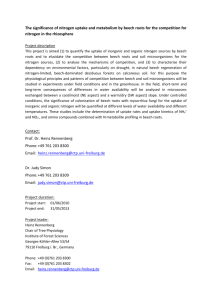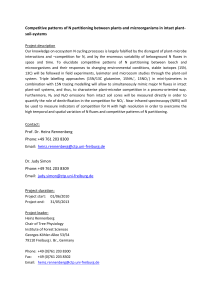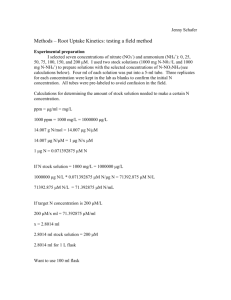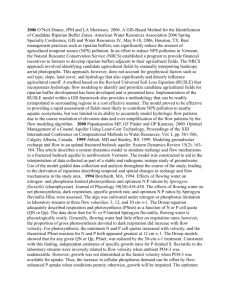Environmental and intrinsic regulation of phosphorus acquisition
advertisement
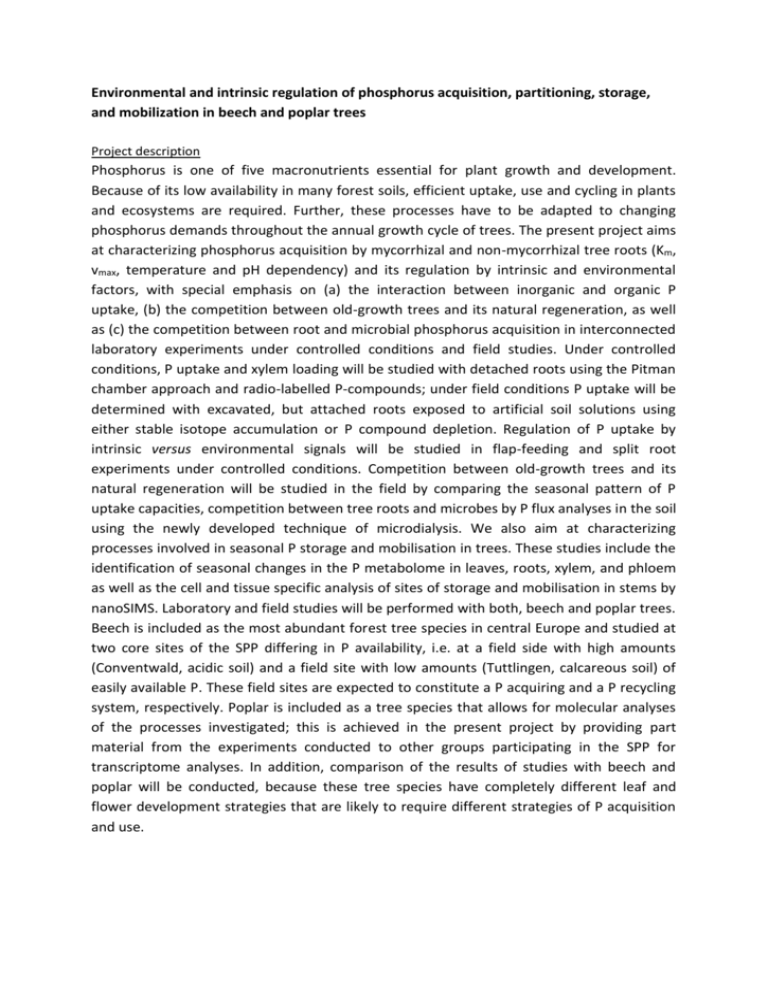
Environmental and intrinsic regulation of phosphorus acquisition, partitioning, storage, and mobilization in beech and poplar trees Project description Phosphorus is one of five macronutrients essential for plant growth and development. Because of its low availability in many forest soils, efficient uptake, use and cycling in plants and ecosystems are required. Further, these processes have to be adapted to changing phosphorus demands throughout the annual growth cycle of trees. The present project aims at characterizing phosphorus acquisition by mycorrhizal and non-mycorrhizal tree roots (Km, vmax, temperature and pH dependency) and its regulation by intrinsic and environmental factors, with special emphasis on (a) the interaction between inorganic and organic P uptake, (b) the competition between old-growth trees and its natural regeneration, as well as (c) the competition between root and microbial phosphorus acquisition in interconnected laboratory experiments under controlled conditions and field studies. Under controlled conditions, P uptake and xylem loading will be studied with detached roots using the Pitman chamber approach and radio-labelled P-compounds; under field conditions P uptake will be determined with excavated, but attached roots exposed to artificial soil solutions using either stable isotope accumulation or P compound depletion. Regulation of P uptake by intrinsic versus environmental signals will be studied in flap-feeding and split root experiments under controlled conditions. Competition between old-growth trees and its natural regeneration will be studied in the field by comparing the seasonal pattern of P uptake capacities, competition between tree roots and microbes by P flux analyses in the soil using the newly developed technique of microdialysis. We also aim at characterizing processes involved in seasonal P storage and mobilisation in trees. These studies include the identification of seasonal changes in the P metabolome in leaves, roots, xylem, and phloem as well as the cell and tissue specific analysis of sites of storage and mobilisation in stems by nanoSIMS. Laboratory and field studies will be performed with both, beech and poplar trees. Beech is included as the most abundant forest tree species in central Europe and studied at two core sites of the SPP differing in P availability, i.e. at a field side with high amounts (Conventwald, acidic soil) and a field site with low amounts (Tuttlingen, calcareous soil) of easily available P. These field sites are expected to constitute a P acquiring and a P recycling system, respectively. Poplar is included as a tree species that allows for molecular analyses of the processes investigated; this is achieved in the present project by providing part material from the experiments conducted to other groups participating in the SPP for transcriptome analyses. In addition, comparison of the results of studies with beech and poplar will be conducted, because these tree species have completely different leaf and flower development strategies that are likely to require different strategies of P acquisition and use. Contact: Prof. Dr. Heinz Rennenberg / Prof. Dr. Cornelia Herschbach Phone: +49 761 203 8300 / 8303 Email: heinz.rennenberg@ctp.uni-freiburg.de cornelia.herschbach@ctp.uni-freiburg.de Project duration: Project start: Project end: 01/07/2013 30/06/2016 Project leader: Heinz Rennenberg Chair of Tree Physiology Institute of Forest Sciences Georges-Köhler-Allee 53/54 79110 Freiburg i. Br., Germany Phone: +49 (0)761 203 8300 Fax: +49 (0)761 203 8302 Email: heinz.rennenberg@ctp.uni-freiburg.de
